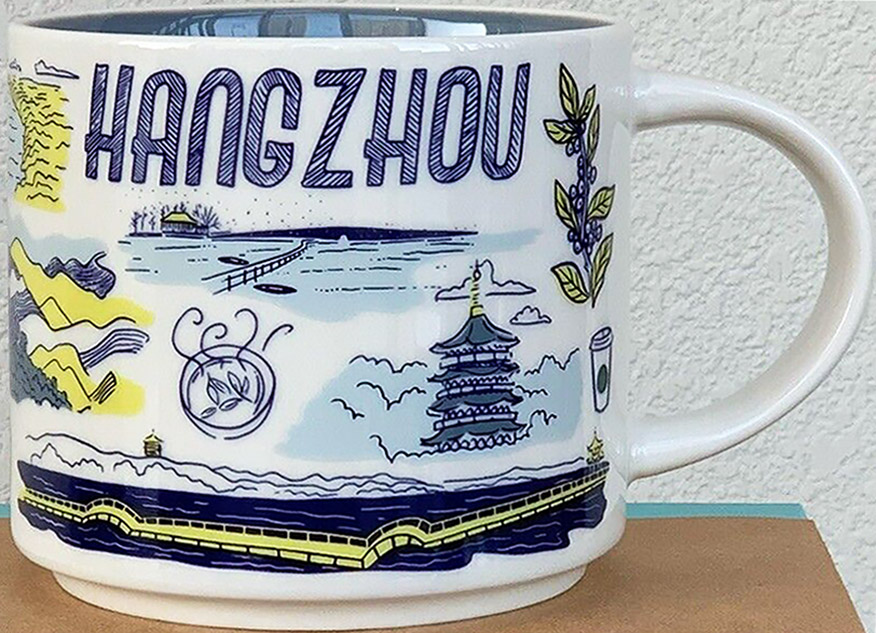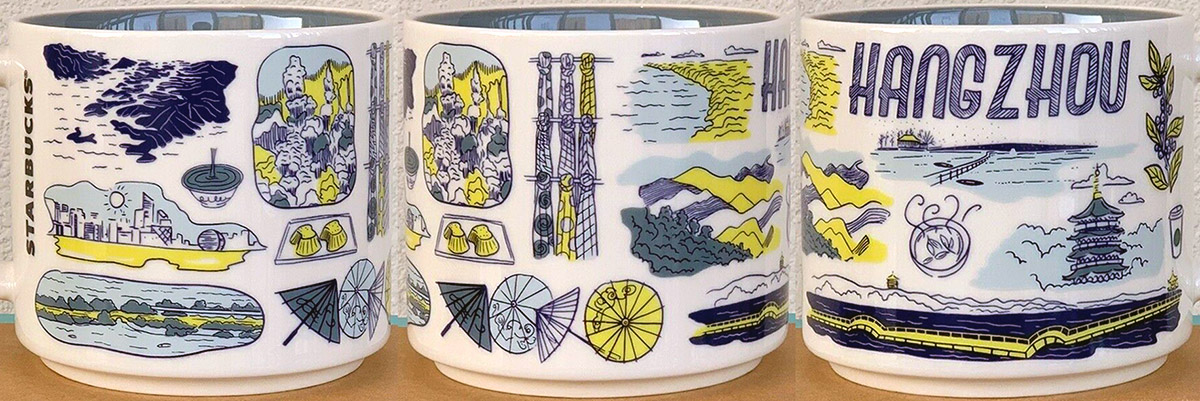
Been There – Hangzhou
Starbucks Been There Hangzhou is a mug for the capital of Zhejiang province in eastern China. It is a city steeped in history and cultural significance. Renowned for its stunning West Lake, Hangzhou has been a center of culture, politics, and economy since ancient times. It was famously described by the Venetian traveler Marco Polo as “the finest and most splendid city in the world.” During the Southern Song Dynasty (1127–1279), Hangzhou served as the imperial capital, fostering a golden age of art, literature, and commerce. The city was a major hub on the ancient Silk Road, linking China to the vast trade networks of Eurasia. Its rich history is evident in its ancient temples, traditional pagodas, and classical gardens, which continue to draw scholars and tourists alike. The historic Grand Canal, a UNESCO World Heritage Site, further underscores Hangzhou’s long-standing significance as a center of Chinese civilization and cultural heritage.
Here are some of the landmarks as seen in the design of the Starbucks Been There Hangzhou mug:
– The West Lake, a UNESCO World Heritage Site, is not only a symbol of Hangzhou but also a serene oasis that has inspired poets and artists throughout history. Its picturesque landscapes, with pagodas, bridges, and lush gardens, offer a glimpse into the city’s harmonious relationship with nature.
– The Six Harmonies Pagoda, standing on the banks of the Qiantang River, is an architectural marvel that offers panoramic views of Hangzhou. This pagoda, built during the Song Dynasty, was originally used as a lighthouse to guide ships on the river. Its impressive structure and scenic location make it a popular attraction.
– Wushan Square, located in the heart of Hangzhou, is a vibrant public square that serves as a cultural hub. Surrounded by historical landmarks, modern buildings, and bustling shops, it is a lively gathering place for locals and visitors alike. The square hosts various events and performances, showcasing the city’s cultural vibrancy.
– The Grand Canal, the world’s longest man-made waterway, flows through Hangzhou and is a testament to the city’s historical significance. This UNESCO World Heritage site played a crucial role in trade and transportation, connecting Hangzhou with other major cities in China. Visitors can take boat tours or stroll along the canal to appreciate its historical and scenic value.
– Longjing Tea, also known as Dragon Well Tea, is a symbol of Hangzhou’s tea culture and craftsmanship. Grown in the surrounding hills, this famous green tea has a distinct flavor and aroma that reflects the region’s unique terroir. It is often enjoyed in traditional tea houses or during tea ceremonies. The National Tea Museum, situated in the Longjing Tea Plantation, is a captivating destination for tea enthusiasts. It offers an in-depth exploration of tea culture, history, and production techniques in China. Visitors can participate in tea ceremonies, taste different teas, and gain a deeper appreciation for the art of tea.
– Silk, a luxurious fabric, symbolizes Hangzhou’s historical role as a prominent center for silk production. The city’s silk industry dates back thousands of years and is known for its intricate designs and high-quality silk products, such as garments, scarves, and home furnishings. The China National Silk Museum is a fascinating place to discover the history and craftsmanship behind silk production. With its extensive collection of silk artifacts, interactive exhibits, and live demonstrations, the museum provides a comprehensive insight into the intricate process of silk-making and its cultural significance in China.
– The history of oil-paper umbrella making in Hangzhou dates back over a thousand years, with the craft reaching its peak during the Tang (618-907) and Song (960-1279) dynasties. These umbrellas are not only practical for protection against rain and sun but also serve as cultural symbols, often used in traditional Chinese weddings and celebrations. The making of oil-paper umbrellas is a meticulous process that involves selecting high-quality bamboo for the frame and applying multiple layers of oil to the paper canopy, making it water-resistant. Hangzhou’s Fuyang district, in particular, is famous for its production of these traditional umbrellas, which are still made by hand today, preserving a rich cultural heritage and artistry that continues to attract tourists and collectors from around the world.
I was not able to identify the dishes from the design of the mug, so I am going to mention these, that you have to try when in Hangzhou:
– West Lake Vinegar Fish: This signature dish features fresh fish, typically grass carp, from West Lake. It is cooked in a sweet and sour vinegar sauce that perfectly balances the flavors, highlighting the freshness of the fish.
– Dongpo Pork: Named after the famous Song Dynasty poet Su Dongpo, this dish consists of succulent, braised pork belly that is slow-cooked with soy sauce, wine, and spices until tender and flavorful. The meat is rich and melts in the mouth, often served with steamed buns.
– Beggar’s Chicken: This unique dish involves wrapping a whole chicken in lotus leaves and then encasing it in clay before baking. The cooking method ensures the chicken remains incredibly moist and infused with the fragrant aroma of the lotus leaves.
















































































